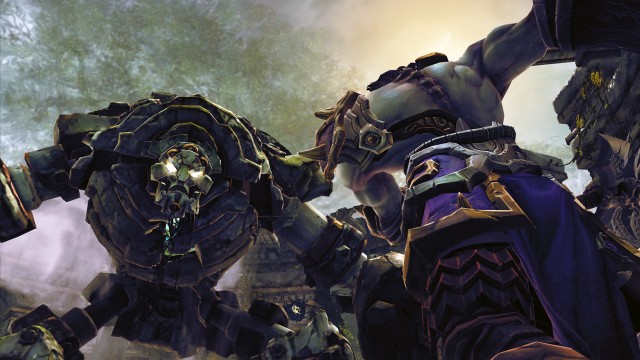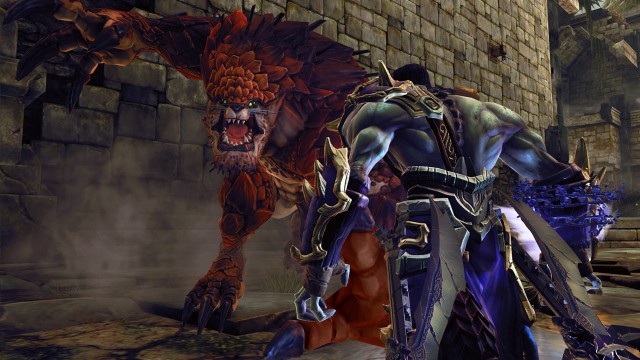The original Darksiders was a mostly successful blend of Devil May Cry action, Ocarina of Time puzzles, and Joe Madureira comic art. It told the story of War, one of the Four Horsemen, who had been wrongly accused of starting the Apocalypse. At the end of the game, the other horsemen were seen rocketing through the sky coming to aid their brother, leaving many to rightfully assume the sequel would continue that story and include some sort of multiplayer aspect.
Unfortunately, Darksiders II takes a step back, telling a parallel story where Death has discovered War’s fate, and goes on a rampage in the Nether Realm to garner enough power and allies to save his brother and bring justice to those that framed him. The game is said to be twice the size of the original, and will feature a loot system similar to RPGs like Diablo or Skyrim, where slain enemies drop different types of equipment and armor.
Where War was a powerful but somewhat slow fighter, Death is much more agile. This becomes readily apparent in not only the turbo-charged combat, but also the platforming as well, which was pretty dull in the original. So even though the game may be bigger, players will be able to explore it in a more energetic, exciting way. As the screenshots and video show, it’s also looking phenomenal, easily sporting one of the most inspired and well-realized visual styles of any current generation game.
GamesBeat sat down with Ryan Stefanelli, producer at Vigil Games, to discuss in what ways Darksiders II plans to be superior to its predecessor.
GamesBeat: How much has THQ showed off Darksiders II at this point?
Ryan Stefanelli: Not a whole lot. A couple of levels, the fact that it’s Death, that he’s got a lot of different abilities compared to War. It takes place in the underworld. The storyline’s concurrent with Darksiders one. There’s a lot more depth to Darksiders II in the form of new abilities, skill trees, there’s loot. Let me know if I’m being too vague, but that’s the kind of stuff we’ve gone into thus far.
GamesBeat: You definitely notice that there’s loot and damage counters when you attack or take damage. Why did you add the very blatant RPG elements into the sequel?
Stefanelli: Well, loot is just something that we love. We’re gamers and we love collecting loot, I’m a loot whore, any game that has collecting loot, I’m almost immediately addicted to. It’s all about that slot machine mechanic, right? Every time you kill a creature, something cool is gonna come out. Even if you have the option to, you don’t want to run by something in that case, you want to see what you’re going to get. From that, the damage numbers are important, because if you’re doing statistical management on loot like that, you get something that has, say, 15 strength instead of 10, the delta if you’re smacking a creature and trying to count the number of hits, it’s negligible. But if you can see those damage numbers go up on your hits, you go from 50 damage to 55, then you know you’re making progress. That’s important feedback. If. players want a more pure action experience, all that stuff can be turned off any time. It can just be them and the creature going at it.
GamesBeat: How exhaustive is the loot system? Is it like Torchlight ridiculous?
Stefanelli: We’re going to do a full reveal on the loot at a later date. It’s pretty deep. We’re not skimping on that.
GamesBeat: How many different weapons? He has the scythes and then the claws, but…
Stefanelli: Some of it we showed in there, we have three different types of weapons. There’s the scythe, which is his main weapon. Actually four I guess if you count the gun. The scythe, then two types of secondary weapons, the heavy weapons — which was the hammer that we saw — and then the claw, the fast secondary weapon that we saw. And then the pistol. I will say that within the secondary weapons, there are a couple of different sub-types that add variety to how they’re used. Within the light weapons there’s a couple, within the heavy weapons too. There’s quite a bit of variety.
GamesBeat: With third-person action games, the melee/gun hybrid gameplay has become pretty standard. It’s seen across many, many games now. So how do you go about differentiating that from everyone else?
Stefanelli: I think one of the things that makes it different for us is that, there’s so much more that you can do besides just use your melee weapon and then the gun. The number of combo varieties is pretty vast. You can be attacking with the melee weapon, knock them in the air, shoot them, kind of a trope of the action genre, right? Or you can hit them into the air, slam them into the ground with the ghost hook, or jump in the air, pull them up in the air with the ghost hook, smack them a few times, shoot them. Then you start mixing in the secondary weapon. Hit them with the primary weapon, then the secondary, knock ’em in the air, juggle them a few times, and on the way back down take a big hit with the secondary weapon. And then cast a spell and have a spell go after them. So I think what differentiates us is the depth of that. We go beyond just a melee weapon and a pistol. You can incorporate secondary weapons, spells, items like the ghost arm. There’s a lot you can do with this. The breadth is pretty cool.
GamesBeat: Is combat generally one-on-one? Obviously Death will be surrounded by multiple enemies, but do his attacks usually just focus on one target at a time while the rest of the AI “waits their turn”?
Stefanelli: Most of his attacks, actually, are AOE. But one of the cool things about the fist weapons, as a secondary weapon, is that they are focused damage. They’re quick strikes on a single target, you can do massive damage to a single target. Whereas the other weapons are a bit more sweeping, because we like to surround people with creatures in Darksiders. That’s core to the experience, feeling like you’re outnumbered but kicking ass anyway. You get surrounded a lot, so the scythe and the heavy weapons are good for that, but when you are one on one with one of the bigger guys, like we saw in the demo — because every now and then it’s just you and a mini-boss or even a towering full-size boss — the fist weapons are pretty lethal in that case.
GamesBeat: You showed three spells, I believe, are there more?
Stefanelli: Oh, yeah, a lot more. We saw a couple of spells from one side of the tree, the Necromancer tree. We didn’t even get into the spells on the other side, the Harbinger tree. Basically, one is melee and one is caster. Caster is tricky because it’s not like you’re ever going to be shooting fireballs, but the summoner stuff, the necromancy, that fits the character of Death. The melee one is more about physical, short-range, in-your-face quick hits. But big, big bangs. We’ll get to show them soon.
GamesBeat: That screen used for the demo was pretty massive and the environments still looked amazing. What have you guys done to amp up the visuals?
Stefanelli: One thing we’re really excited to do with [Darksiders] II is go push the stylistic edge of the game a little bit further than we did in Darksiders one. To go a little bit truer to Joe Mad’s art style. I think we captured it pretty well in Darksiders one, but… It’s tricky, because the game took place on earth. We had this really cool fusion of fantasy meets reality. Darksiders 2 is more about the fantasy, which is something we really wanted to explore more of in Darksiders one, but we didn’t get a chance. Because we’re down in the underworld, it’s just imagination run wild for the most part, and the art team really embraced the opportunity to do that. They’ve really pushed it to the limits in terms of scale and stylistic quality. Color is something that’s very important, adding artistic value to the visuals, so lots of color, lots of richness. We want the screen to be like eye candy.
GamesBeat: Speaking of the first game, what were some of the things you wanted to do, or some of the feedback that you got that you’ve incorporated into this one?
Interview continues on the next page.


